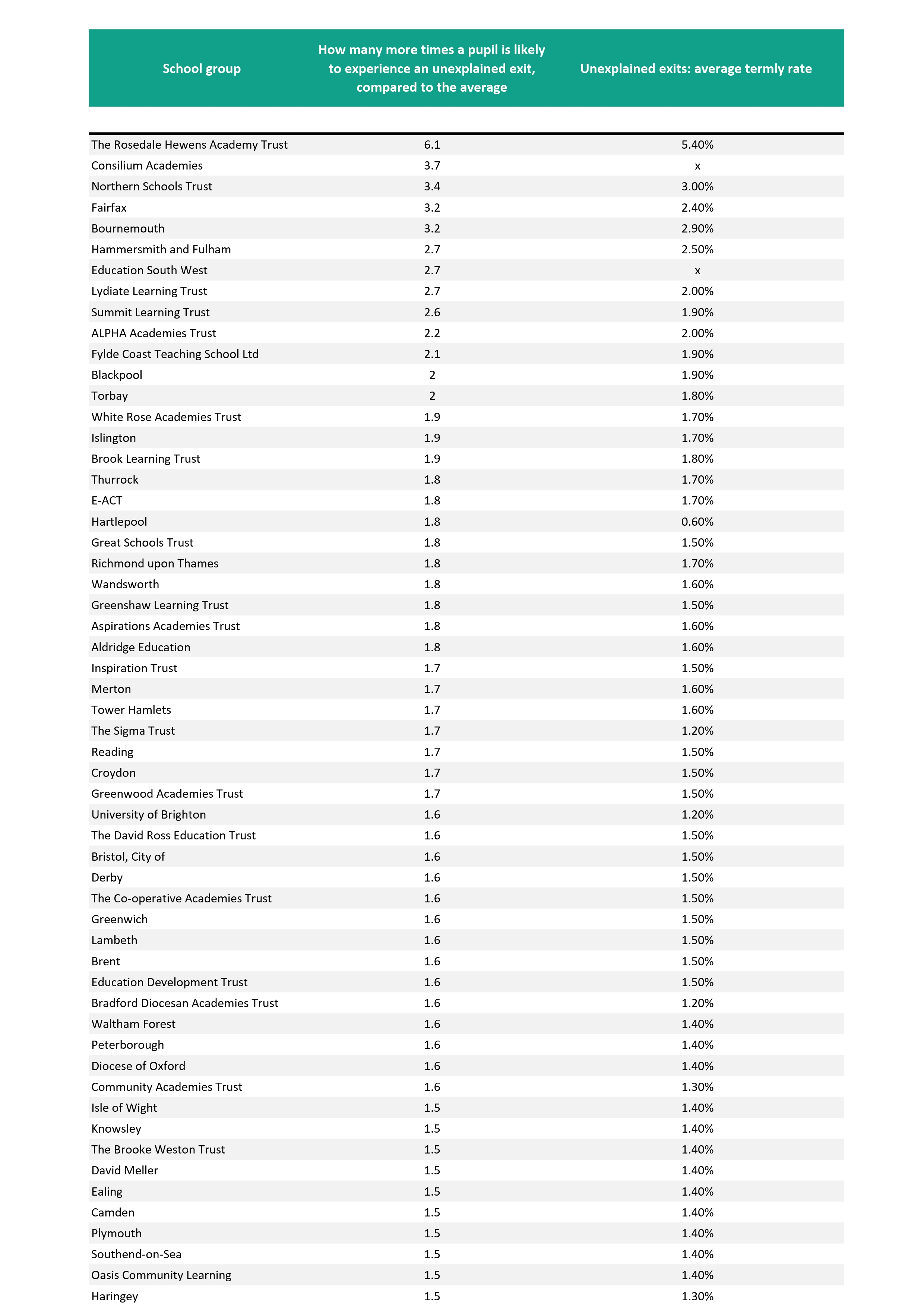The Education Policy Institute (EPI) has published new research examining unexplained pupil exits from English schools.
The new study builds on previous EPI research, published in April – providing the most refined estimate to date on unexplained pupil exits in the school system. For the first time, the report also highlights which school groups have the highest rates.
You can download the full report here.
Scope of the research
While the number of official school exclusions is recorded by the government, less is known about the practice of schools removing pupils by other, informal means. These pupil exits are not consistently recorded or regulated.
In April 2019, EPI published a report examining the prevalence of unexplained exits at a national level, for the first time highlighting the full scale of the phenomenon. The study considered pupil exits that did not appear to be instigated by families, examining both those that had taken place between schools, and those involving pupils leaving the school system entirely.
This second report, which is sponsored by the National Education Union (NEU), builds on the initial research by:
- Refining national estimates on unexplained pupil exits, using an improved methodology.
- Highlighting, for the first time, which school groups have the highest rates of unexplained pupil exits (see breakdowns below).
Key findings
Unexplained pupil exits at a local level
- Very high rates of unexplained pupil exits from schools are evident among several local authorities (LAs) and multi-academy trusts (MATs) in England.
- In over a dozen school groups, a pupil is at least twice as likely to experience an unexplained exit than the average, with those in the highest school group six times as likely.
- While there is not a large difference between MATs and LAs in rates of unexplained exits, overall, larger MATs have above average rates. Most of these MATs also have above average rates of permanent school exclusions.
- Within some school groups, unexplained exits are concentrated in a small number of schools. In the year group that finished their GCSEs in 2017, two MATs and seven LAs have one school which lost at least the equivalent of an entire class of pupils (30 children) over five years.
Unexplained pupil exits nationally
- Nationally, the latest figures indicate a very high rate of exits from schools: as many as 1 in 10 pupils (10.1 per cent) in the 2017 cohort experienced exits at some point during their time at secondary school that cannot be accounted for. This totals over 69,000 unexplained exits by over 61,000 pupils.
- The proportion of pupils that left school rolls with no explanation is higher in this most recent 2017 school year group. In the previous cohort in the study – those that finished their GCSEs in 2014 – the latest figures show that 1 in 11 pupil exits (9.0 per cent) could not be accounted for (totalling around 62,000 exits by over nearly 56,000 pupils).
- A significant proportion of all pupils experiencing an unexplained exit fail to return to the school system ever again: as many as 4 in 10 (24,000) pupils experiencing an unexplained exit in the 2017 cohort did not return at all.
Which pupils are more likely to experience an unexplained exit from schools?
The overwhelming majority of unexplained exits – around three quarters – are experienced by vulnerable pupils. They include:
- Over 1 in 3 (36.2%) of all pupils who had also experienced a permanent exclusion;
- Around 1 in 3 (29.8%) of all looked after pupils (those in social care);
- Over 1 in 4 (27.0%) of all pupils with identified mental health needs (SEMH);
- Around 1 in 6 (15.6%) of all poorer pupils (those who have ever been on free school meals);
- Around 1 in 6 (15.7%) of all pupils with identified special educational needs (SEND);
- Around 1 in 7 (13.9%) of all pupils from black ethnic backgrounds.
Unexplained exits by Ofsted grade
- A majority of pupils experiencing unexplained exits (52%) fail to join any school in the term immediately following the exit.
- Of those that do enter into a school (with an Ofsted grade) in the term following the exit (45%) these pupils are generally not moving to a higher rated school. Just over a quarter of these pupils (28.6%) join a school that is rated as ‘Requires Improvement’ or ‘Inadequate.’
Policy recommendations
- Far better data, monitoring and transparency around pupil moves in the school system is urgently required. This is especially the case for ‘voluntary’ managed moves between schools, as well as pupil moves out of the system into home schooling. Decisions on extra support for pupils with SEND should be made independently, rather than by local authorities that are also responsible for delivering that support
- The government should improve guidance given to schools, so that it genuinely recognises the complex causes of pupils’ behavioural difficulties, and offers schools clear information and training on their responsibility to support pupils with SEND.
- School performance and accountability measures should take account of the vulnerability of pupil intakes, and reward more inclusive schools. The system should promote a broader conception of school performance, that accounts for children’s health and development.
- The government’s review of high needs funding should consider implementing a funding allocation system that promotes inclusion and early support for children with SEND.
Local authorities and multi-academy trusts with the highest rates of unexplained pupil exits from their schools (2017 cohort)
See full report for complete tables.




